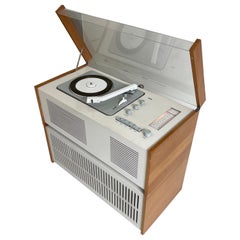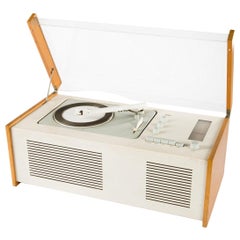Braun Sk61
Recent Sales
Vintage 1960s German Industrial Musical Instruments
Metal
Vintage 1960s German Mid-Century Modern Musical Instruments
Steel
Vintage 1960s German Mid-Century Modern Musical Instruments
Steel
Vintage 1960s German Mid-Century Modern Musical Instruments
Vintage 1960s German Mid-Century Modern Musical Instruments
Dieter Rams for sale on 1stDibs
German industrial designer Dieter Rams is revered for the pared-down, intuitive electronics and consumer goods he created for Braun — where he worked from 1955 to 1997, most of that time as chief design officer — and his timeless furniture for Vitsœ, a company with which he continues to collaborate today.
Less well known are Rams’s longstanding focus on sustainability and uneasy relationship with contemporary technology, even as Silicon Valley designers like Apple’s Jonathan Ive follow in his rational footsteps.
During Germany’s postwar rebuilding period, Rams and his team of designers at Braun, inspired by the Bauhaus and the Ulm School of Design, focused on extreme simplicity and usability while conceiving products with a modern, forward-looking appearance.
Among Rams’s most iconic designs is the SK 4 phonograph and radio, created in 1956, which had a compact white metal case topped by a revolutionary-at-the-time transparent Plexiglas lid that revealed simple gray controls inside (it was nicknamed Snow White’s Coffin). But it is the T3 portable radio, from 1958, that gets design aficionados most excited today: A white rectangular box with a perforated square for the speaker and a circular-dial control, it bears an unmistakable resemblance to Apple’s original iPod. (Many people also note that the iPhone’s calculator app looks remarkably similar to the Braun ET 66 calculator, with its circular color-coded buttons.)
In the late 1970s, Rams laid out his widely studied 10 principles for good design: It is innovative, makes a product useful, is aesthetic, makes a product understandable, is unobtrusive, is honest, is long lasting, is thorough down to the last detail, is environmentally friendly and is as little design as possible.
One of Rams’s principles that hasn’t translated to our contemporary era is his emphasis on longevity. “The time of thoughtless design and thoughtless consumption is over,” he said in 1976, stressing the need to conserve natural resources — even as he was busy designing plastic products.
Rams has also expressed reservations about how electronics have evolved in recent decades from tools for improving life to time-sucking obsessions. “Every time he crosses a street and sees people glued to their phones, he just can’t conceive of how we got to this point,” says filmmaker Gary Hustwit, whose feature-length documentary on Rams debuted in 2018. “I think he’s a little bit saddened by all this work they did in the fifties and sixties, which had a very idealistic point of view, being a stepping stone to where we are now, and the current lust for technology.”
If digital devices sometimes seem to be making life more complicated, Rams’s precept remains the same as always: “Back to purity, back to simplicity.”
Find vintage Dieter Rams furniture on 1stDibs.
Finding the Right musical-instruments for You
Pay tribute to a history of rich and diverse musical traditions that have taken shape all over the world by decorating your home with a collection of antique and vintage musical instruments.
Whether you’re playing them or merely displaying them, vintage musical instruments, when cared for properly, can be a wonderful addition to any space. At between four and five feet in length, an elegant early-1900s Steinway & Sons baby grand piano will undoubtedly steal the show if you’re thinking of yielding some precious real estate to one of these American classics, but maybe you’re simply shopping for art to warm the bare walls of your new apartment or weekend home.
For your living room, maybe you’ve already hunted down portraits by Gered Mankowitz, a celebrated 1960s-era photographer who spent his life capturing iconic images of music’s biggest stars. If you’ve got more space to work with there — or perhaps you need some entertainment room ideas — consider positioning an old guitar as a focal point. If a room has no distinguishing architectural features, you could create a prominent focal point with trending paint colors, stylish shelving, an arrangement of flowers or by wall-mounting a spectacularly aging early-20th-century guitar or other stringed instrument.
Alternatively, much in the way that you might group a collection of artwork to hang salon-style, with a little help from strong hanging wire or some wall hooks, vintage brass instruments such as a gong, French horn or trumpet can help elevate a home office or complement the efforts you’ve made to ensure a welcoming vibe in your home’s entryway. Bells or antique wind instruments can add provocative metallic contrasts to dark woods as tabletop decorative objects. Think of them as eye-catching ornamental flourishes that you can bring to end tables in a common area, to the top of a desk or to a mid-century storage cabinet.
Bring culture and creativity into your space with decades-old plywood tabletop radios or musical instruments from all over the world — be they drums from Africa or harps from France. Even if you’re not exactly getting the band back together, we can promise that the range of antique and vintage instruments on 1stDibs can help strike a meaningful chord in your interior design plan.

